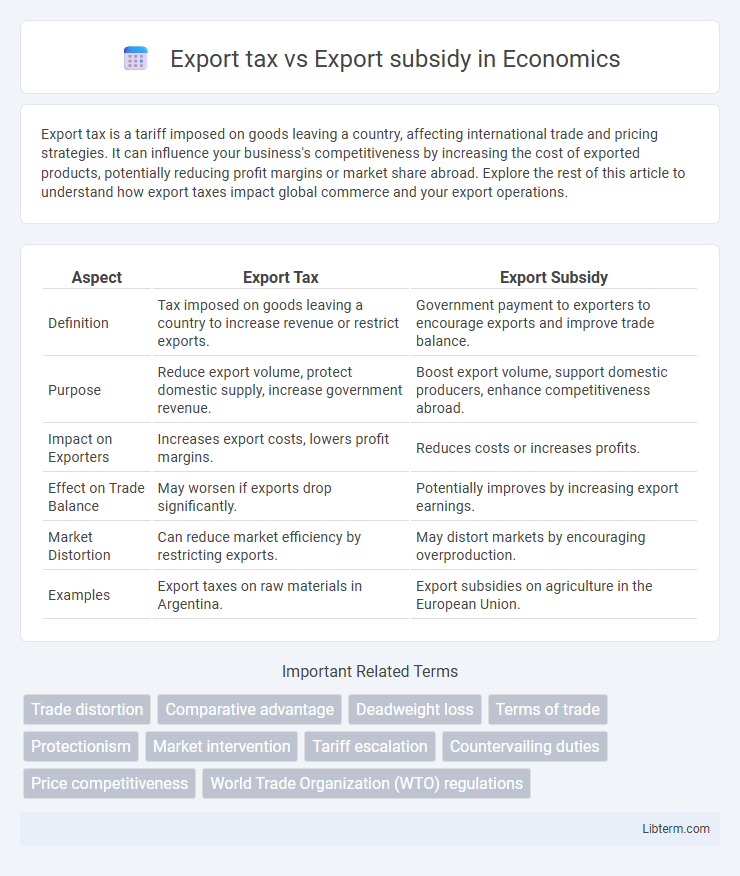Export tax is a tariff imposed on goods leaving a country, affecting international trade and pricing strategies. It can influence your business's competitiveness by increasing the cost of exported products, potentially reducing profit margins or market share abroad. Explore the rest of this article to understand how export taxes impact global commerce and your export operations.
Table of Comparison
| Aspect | Export Tax | Export Subsidy |
|---|---|---|
| Definition | Tax imposed on goods leaving a country to increase revenue or restrict exports. | Government payment to exporters to encourage exports and improve trade balance. |
| Purpose | Reduce export volume, protect domestic supply, increase government revenue. | Boost export volume, support domestic producers, enhance competitiveness abroad. |
| Impact on Exporters | Increases export costs, lowers profit margins. | Reduces costs or increases profits. |
| Effect on Trade Balance | May worsen if exports drop significantly. | Potentially improves by increasing export earnings. |
| Market Distortion | Can reduce market efficiency by restricting exports. | May distort markets by encouraging overproduction. |
| Examples | Export taxes on raw materials in Argentina. | Export subsidies on agriculture in the European Union. |
Understanding Export Taxes
Export taxes are tariffs imposed by governments on goods sold to foreign markets, aimed at increasing domestic revenue or controlling scarce resources. They can reduce a country's export competitiveness by raising the cost for foreign buyers and potentially triggering retaliatory trade measures. Understanding export taxes involves analyzing their impact on international trade balance, domestic industries, and global price dynamics.
Defining Export Subsidies
Export subsidies are government financial benefits provided to domestic producers to encourage exports, often through direct payments, tax relief, or reduced export costs. These subsidies aim to enhance a country's export competitiveness by lowering production or shipping expenses, thereby increasing market share in global trade. Unlike export taxes, which impose extra costs on exports to restrict them, export subsidies promote outward trade by making exports cheaper and more attractive to international buyers.
Key Differences: Export Tax vs Export Subsidy
Export tax imposes a financial burden on goods leaving a country, aimed at reducing exports or generating government revenue, while export subsidy provides financial incentives to exporters to increase competitiveness in international markets. Export taxes typically decrease export volume and can protect domestic resources, whereas export subsidies boost export volume by lowering production costs and encouraging trade expansion. The key difference lies in their opposite economic impacts: export taxes discourage exports, whereas export subsidies promote them.
Economic Impact of Export Taxes
Export taxes increase the cost of goods for foreign buyers, leading to reduced export volumes and decreased competitiveness in global markets. This often results in lower export revenues, negatively impacting national income and potentially causing trade distortions. Countries imposing export taxes may experience retaliatory trade measures, worsening long-term economic growth and foreign investment prospects.
Economic Impact of Export Subsidies
Export subsidies boost domestic producers by lowering export costs, thereby increasing international competitiveness and stimulating economic growth. These subsidies can lead to trade distortions by encouraging overproduction and market imbalances, often provoking retaliatory tariffs from trading partners. While they can enhance employment and industrial output in targeted sectors, export subsidies risk long-term inefficiencies and strain fiscal resources.
Effects on Domestic Industries
Export taxes increase the cost of goods for foreign buyers, reducing international demand and potentially protecting domestic industries from excessive competition by limiting the outflow of key resources. Export subsidies lower the cost for domestic producers to sell goods abroad, boosting export volumes and encouraging production growth in targeted industries, but may lead to resource depletion or inflation domestically. Both policies significantly influence domestic industrial competitiveness, resource allocation, and overall economic growth trajectories.
Influence on International Trade Relations
Export taxes often strain international trade relations by increasing product prices, leading to reduced competitiveness and potential retaliatory tariffs from trading partners. Export subsidies, by lowering export costs, can enhance market access and stimulate trade volumes but may provoke disputes under World Trade Organization (WTO) rules due to accusations of unfair trade advantages. Both policies significantly impact trade balance and diplomatic ties, influencing negotiations and cooperation in global trade frameworks.
Case Studies: Countries Implementing Export Taxes
Export taxes are levies imposed by countries such as India and Indonesia to control the supply of raw materials and promote domestic processing industries, leading to increased local value addition and job creation. In contrast, export subsidies used by nations like China and South Korea aim to enhance international competitiveness by lowering the cost of exported goods, boosting foreign exchange earnings and market share. Case studies reveal export taxes often result in short-term revenue gains but may trigger trade disputes, whereas export subsidies risk international sanctions but effectively support nascent industries.
Case Studies: Countries Utilizing Export Subsidies
Brazil and China are prominent examples of countries utilizing export subsidies to boost their agricultural and manufacturing sectors, respectively. Brazil's use of export subsidies in the ethanol industry has enhanced global competitiveness and increased market share in the renewable energy sector. China's export subsidies target high-tech products and textiles, allowing domestic firms to penetrate international markets while maintaining favorable balance of trade figures.
Policy Implications and Strategic Recommendations
Export tax policies reduce international competitiveness by increasing the cost of goods abroad, often discouraging export volume and potentially triggering retaliatory trade measures. Export subsidies improve market access and boost domestic producers' global reach but risk distorting trade, inviting disputes under World Trade Organization rules. Strategic recommendations include assessing sector-specific impacts, balancing short-term economic gains against long-term trade relationships, and aligning export policies with broader industrial and trade objectives to ensure sustainable growth.
Export tax Infographic

 libterm.com
libterm.com